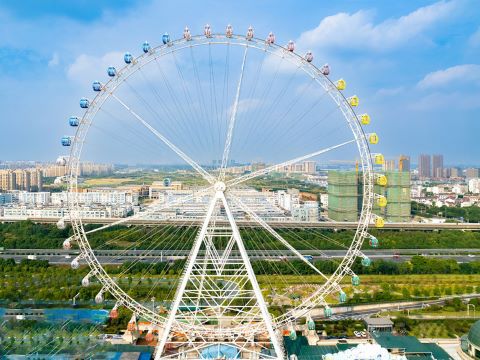Ferris wheels are iconic amusement park attractions, offering stunning views and a gentle, scenic experience. However, the safety mechanisms that ensure smooth operation are highly sophisticated. These massive structures are equipped with advanced safety technologies to address potential risks, making ferris wheel rides some of the safest thrilling rides available.
The Evolution of Safety in Thrilling Rides
Over the years, safety standards for thrilling rides have significantly advanced. Ferris wheels, despite their seemingly simple design, now incorporate cutting-edge technologies. From their construction to day-to-day operations, these rides must address challenges related to height, weight, and exposure to natural elements. One key risk ferris wheel rides face is high winds. Modern wheels use wind sensors that monitor conditions in real-time, automatically halting the ride if wind speeds exceed safe limits.
Braking Systems and Redundancy
Hydraulic braking systems are essential in controlling the movement of ferris wheel rides, ensuring safe and smooth stops. These brakes, combined with redundancy systems, guarantee that if the primary brakes fail, secondary ones immediately engage to prevent accidents. Manual operation systems also allow for the safe lowering of passengers during power outages, further enhancing operational security.
Cabin Safety and Passenger Restraints
Passenger safety is a top priority. Modern ferris wheel cabins feature automatic locking systems that prevent doors or bars from opening during operation. Additionally, larger Ferris wheels often include seat belts or restraint bars, providing extra security. Cabins are constructed using shatterproof glass or reinforced materials, reducing risks from external impact or unexpected cabin movement.
Structural Integrity and Maintenance
The steel framework of ferris wheels must withstand immense loads, dynamic forces, and weather conditions. Routine inspections using both visual checks and advanced testing methods, like ultrasonic testing, help identify any potential structural weaknesses. Real-time monitoring systems track key components, alerting operators if any anomalies, such as excessive vibrations, are detected.
Weather Monitoring Systems
Weather presents a significant challenge for ferris wheel rides. To address this, Ferris wheels are equipped with advanced weather monitoring systems, including wind sensors and lightning detection. If unsafe conditions arise, the ride can be automatically slowed or stopped. Grounding systems also protect the ride from lightning strikes by directing electrical currents away from the structure.
Operator Training and Emergency Procedures
Highly trained operators play a vital role in ensuring the safety of ferris wheel rides. They are prepared to manage routine operations and respond to emergencies. In the event of a mechanical failure, many Ferris wheels have manual evacuation protocols to safely lower passengers. Communication systems between operators and passengers further enhance safety by keeping riders informed during unexpected stops.
Conclusion
Safety mechanisms in ferris wheel rides are a testament to the industry’s dedication to passenger protection. Through the use of advanced braking systems, real-time monitoring, and rigorous structural integrity checks, Ferris wheels remain among the safest thrilling rides in amusement parks.



